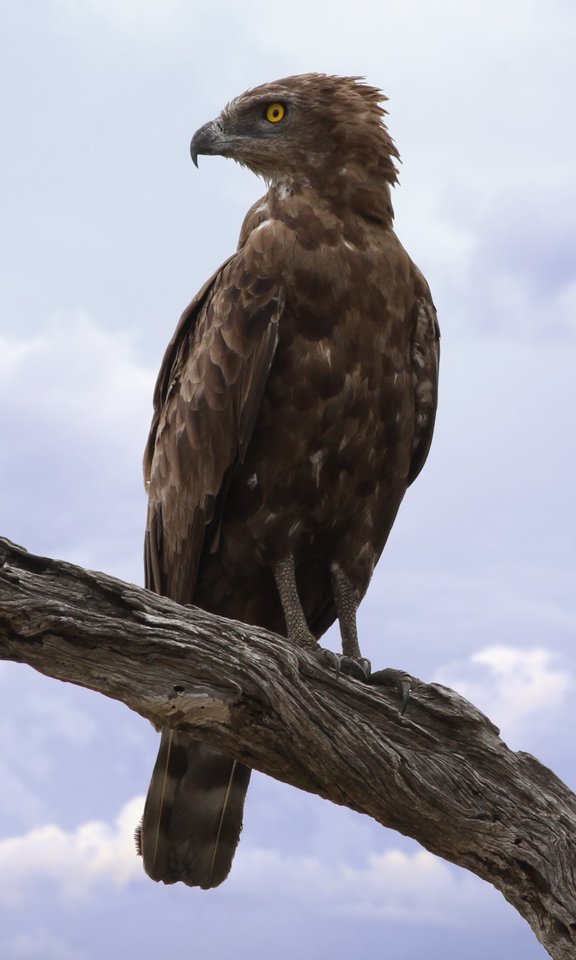The Brown Snake Eagle (Circaetus cinereus) is a large bird of prey found in West, East, and southern Africa. It is a specialized predator of snakes, with a prolonged breeding cycle and solitary behavior. The typical lifespan of a Brown Snake Eagle is around 7-10 years, which is relatively short for an eagle.
The Lifespan of the Brown Snake Eagle
The Brown Snake Eagle has a relatively short lifespan compared to other eagle species. On average, these birds live for 7-10 years in the wild. However, some individuals have been known to reach up to 15 years of age, though this is quite rare.
Physical Characteristics
 Image source: Brown snake eagle By Derek Keats
Image source: Brown snake eagle By Derek Keats
Brown Snake Eagles are the largest of all snake eagles, with a length of 68-75 cm, a wingspan of 164 cm, and a weight of 1.5-2.5 kg. They have a dark brown head and body, with mottled white flight feathers and a gray underwing. The tail is brown with narrow white barring and a white tip. The cere, long bare legs, and feet are pale gray. The beak is black, and the eyes are yellow.
Habitat and Distribution
Brown Snake Eagles live in arid open and dense woodland, at 0-2,500 meters above sea level. They tend to prefer habitat more densely wooded than Circaetus pectoralis (Black-Chested Snake Eagle), and they do not live in lowland forest areas, also avoiding treeless country and desert. They live across Africa, from Mauritania and Senegal east to Sudan and Ethiopia and south through Angola, Zambia, and Malawi to South Africa, a total range that spans from 18°N to 29°S.
Diet and Hunting
Most of their diet is snakes, though they eat other animals such as lizards, guineafowl, and similar birds, and small mammals. Brown Snake Eagles take snakes up to 2.8 meters long, and often hunt venomous ones. They crush the head of any snake they catch to discharge venom, and they have thick, scaly skin on their legs for protection from bites. Despite those defenses, spitting cobras have been known to blind them. They hunt by swooping down from a perch and catching their prey on the ground. Unlike other snake eagles, they rarely or never eat in flight.
Reproduction
Breeding displays consist of dives and soars, and are usually done by only one bird. Pairs may have fairly large territories of up to 200 km². Egg-laying season is year-round. A stick nest 60-70 cm wide and 15-30 cm deep is built and set 3.5-12 meters above the ground, or the nest of another bird (such as Aquila rapax (Tawny Eagle), Aquila wahlbergi (Wahlberg’s Eagle), Aquila spilogaster (African Hawk Eagle), or Polyboroides typus (African Harrier Hawk)) is used. The nest is lined with green leaves. Clutch size is 1 egg, and it is incubated by the female for 48-53 days. Newly-hatched chicks are snow white and take 96-113 days to fledge. They are fully independent of their parents two weeks to one month after fledging.
Conservation Status
Brown Snake Eagles have a large range and are thinly distributed. They are not threatened in southern Africa, although they live in higher numbers in protected areas, indicating that there is some habitat destruction and human disturbance. The population appears stable, and they are currently listed as Least Concern by BirdLife International.
References:
– Animals Fandom – Brown Snake Eagle
– World Life Expectancy – Brown Snake Eagle
– Eagle Encyclopedia – Brown Snake Eagle
– The Peregrine Fund – Brown Snake Eagle
– Wildlife of Kenya – Brown Snake Eagle

